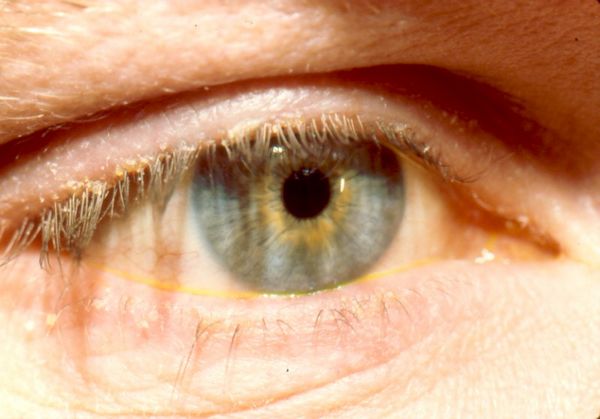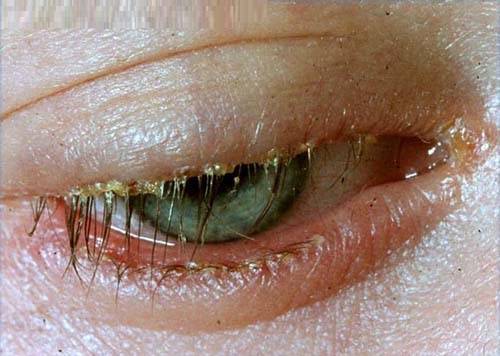Description of Medical Condition
An inflammatory reaction of the eyelid margin. It usually occurs as seborrheic (non-ulcerative) or as staphylococcal (ulcerative) blepharitis.
Both types may coexist.
System(s) affected: Skin/Exocrine
Genetics: N/A
Incidence/Prevalence in USA: Common (the most frequent ocular disease)
Predominant age: Adult
Predominant sex: Male = Female
Medical Symptoms and Signs of Disease
Staphylococcus aureus blepharitis
- Itching
- Lacrimation; tearing
- Burning
- Photophobia (light sensitivity)
- Usually worse in morning
- Recurrent stye (external hordeolum, or internal hordeolum)
- Recurrent chalazia (chronic inflammation of meibomian glands)
- Fine, epithelial keratitis, lower half of cornea
- Ulcerations at base of eyelashes
- Broken, sparse, misdirected eyelashes(trichiasis)
Seborrheic blepharitis
- Lid margin erythema
- Dry flakes, oily secretions on lid margins and/or lashes
- Associated dandruff of scalp, eyebrows
- Sometimes nasolabial erythema, scaling
Mixed blepharitis (seborrheic with associated Staph aureus)
- Most common type of blepharitis
- Symptoms and signs of both staph and seborrheic present

What Causes Disease?
Seborrheic
- Accelerated shedding of skin cells with associated sebaceous gland dysfunction
- P. ovale and P. orbiculare yeasts often colonize
- Oil and skin cells foster staph growth
Staphylococcus
- Usually part of mixed blepharitis
- Colonization of Zeis glands of lid margin and meibomian glands posterior to lashes, with Staphylococcus aureus
- Impetigo contagiosa-staphylococcus
- Infectious eczematoid dermatitis-Staphylococcus is the hapten
- Staphylococcus scalded skin syndrome — entire body involved (in young children)
- Angular blepharitis staph — most frequent bacteria involved
Other types of blepharitis
- Contact dermatitis with or without secondary Staphylococcus infection
- Meibomian gland dysfunction
Risk Factors
- Candida
- Seborrheic dermatitis
- Acne rosacea
- Diabetes mellitus
- Immunocompromised state (AIDS, chemotherapy, etc.)
Diagnosis of Disease
Differential Diagnosis
Masquerade syndrome:
- Persistent inflammation and thickening of eyelid margin may indicate squamous cell, basal cell, or sebaceous cell carcinoma masquerading as “blepharitis”
- These carcinomas may also mimic styes or chalazions
- Sebaceous cell carcinoma has a 23% fatality rate (found in one study of eyelid sebaceous cell carcinomas). Up to one half of potentially fatal sebaceous cell carcinomas may resemble benign inflammatory diseases, particularly chalazions and chronic blepharoconjunctivitis.
- Any swelling or inflammation of eyelid which does not resolve promptly (within one month) with treatment, is suspect as a possible underlying carcinoma
Drugs that may alter lab results: N/A
Disorders that may alter lab results: N/A
Pathological Findings
Acute or chronic inflammatory cell types
Special Tests
- Cultures in atypical blepharitis
- Biopsy in atypical cases that are suspect for carcinoma
Diagnostic Procedures
See Special Tests
Treatment (Medical Therapy)
Appropriate Health Care
Outpatient
General Measures
- Mild seborrheic blepharitis (dry flakes, minimal inflammation) — apply eyelid margin scrubs with eyelid cleanser at least once daily
- If Staphylococcus likely, follow lid scrubs with application of bacitracin, or (second choice), erythromycin ophthalmic ointment, to eyelid margins, using cotton tipped applicator
- Clean lids and apply ointment nightly in mild cases, up to four times daily in severe cases
- Discontinue soft contact lenses until condition cleared
- Chronic recurrent blepharitis requires referral to ophthalmologist for evaluation as to whether patient should continue in lenses
Activity
No restrictions
Diet
No restrictions
Patient Education
- Blepharitis “Fact Sheet” from American Academy of Ophthalmology (see References for ordering information)
- Advise patient that blepharitis is a chronic condition, prone to recurrence if hygiene (lid scrubs) are not maintained after antibiotic treatment is discontinued
Medications (Drugs, Medicines)
Drug(s) of Choice
- Topical treatment, if Staphylococcus likely, application of bacitracin, or (second choice), erythromycin ophthalmic ointment
- In some cases of Staphylococcus blepharitis (e.g. rosacea), systemic tetracycline 250 mg qid x several weeks, tapering to 250 mg daily for one to three months, or doxycycline 100 mg bid po. Alternative is oxacillin 250 mg qid for 1-2 weeks. Used for persistent (despite topical treatment) lid inflammation or recurrent meibomian styes.
Contraindications:
- Allergy to medication
- Tetracycline: not for use in pregnancy or children < 8 years

Precautions:
- Avoid medication containing neomycin, as it is sensitizing
- Tetracycline: may cause photosensitivity; sunscreen recommended
Significant possible interactions:
- Tetracycline: avoid concurrent administration with antacids, dairy products, or iron
- Broad-spectrum antibiotics: may reduce the effectiveness of oral contraceptives; barrier method recommended
Alternative Drugs
Quinolones may be helpful for persistent or recurrent Staphylococcal blepharitis
Patient Monitoring
Every 2 months
Prevention / Avoidance
Follow treat ment guidelines
Possible Complications
- Hordeolum (stye)
- Scarring of eyelid margin
- Misdirection of eyelashes (trichiasis)
- Corneal infection
Expected Course / Prognosis
Long-term eyelid hygiene required to control
Miscellaneous
Associated Conditions
See Diagno sis section above regarding blepharitis masquerade syndromes
Age-Related Factors
Pediatric: N/A
Geriatric: N/A
Pregnancy: N/A
International Classification of Diseases
373.00 Blepharitis, unspecified


